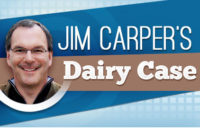Why ice cream melts
Have you ever thought about how ice cream melts? If you put two scoops of ice cream from different manufacturers on a plate, chances are they will melt at different rates. Air, ice and fat all play roles.
The meltdown of ice cream is an important facet of ice cream science, according to Richard Hartel, a professor at the University of Wisconsin-Madison, and Maya M. Warren, the director of the Frozen Dessert Center, and it’s currently under study in the Frozen Dessert Center at the University of Wisconsin-Madison.
Ice cream is a complex frozen dessert typically made from milk fat (at least 10% for the United States), sweeteners (typically sucrose), stabilizers and emulsifiers. This mix, after being pasteurized, homogenized and aged, is then frozen in a scraped-surface heat exchanger.
During freezing, ice crystals are formed, of course, but air is also incorporated and the phenomenon of partial-coalescence of fat globules takes place. Controlling these fat globules is key to controlling melting, according to Hartel and Warren.
Frozen ice cream is composed of ice crystals, air cells, individual fat globules and partially coalesced fat globule clusters surrounded by a serum phase. The process of forming clusters from individual fat globules is often called partial coalescence, which is influenced by formulation factors (for example, emulsifier type and content) and processing conditions (shear rate during freezing). These clusters are an important key to how ice cream melts… read more here.
The science behind chocolate ice cream
Chocolate is second only to vanilla as the most popular ice cream flavor in the United States. Therefore, it is a major component of the product portfolios of most ice cream companies, representing on average of 8% to 10% of the volume of a typical portfolio.
To formulate a quality product, you must understand the properties and attributes of cocoa and chocolate. Then you can achieve the desired flavor, body, texture and color.
Dairy Foods' columnists Bruce Tharp and Steve Young, authors of Tharp & Young on Ice Cream: An Encyclopedic Guide to Ice Cream Science and Technology, offer up their expertise on what goes into making chocolate ice cream.
Chocolate ice cream is distinguished from other ice cream flavors by a variety of factors related to composition, flavor, body (chew/bite), texture (smoothness), color and how it is regulated. As a result, its production usually involves the preparation of a separate mix that differs in its composition from that of a typical “white” mix.
Understanding cocoa
Cocoa products used to flavor chocolate ice cream are usually used at a level in the range of 2% to 6%, but most frequently 2% to 4%. The most common include cocoa powders with fat levels of either 10% to 12% or 20% to 22%. Occasionally, chocolate liquor, with 50% fat, is used. Important variables include cocoa fat content; particle size; color; pH; solubility; bean source; and processing conditions. Proper selection of the type and level of any ingredient used to deliver chocolate flavor (and color) profile is critical… learn and read more about working with cocoa in ice cream here.





